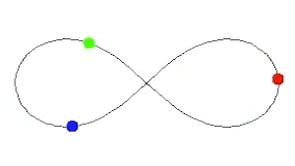

Published on the 11th June 2024 by ANSTO Staff
In Part 1, ANSTO scientist Dr Pablo Galaviz explained the concept and provided historical context. In Part 2, Pablo continues the history of the three-body problem with an exploration of the role of chaos in the system. He also provides some relevance to ANSTO.
Poincaré determined that some configurations of a triple system can be chaotic. For those systems, a tiny difference in the initial condition leads to a divergence in the orbits. The possible outcomes of chaotic systems are the escape of one of the bodies or a collision of two of them. In a chaotic system, the three-body configuration only lasts for a handful of orbits.
On the other hand, many solutions are periodic-stable. Jacobian, or hierarchical, systems are configurations composed of two parts: a binary and a third body orbiting far away. A subclass of periodic solutions is where every particle moves periodically in a single closed orbit. Such solutions are known as choreographic.
An example of choreographic solutions is Moore’s Figure Eight (depicted above). In recent years improvements in computational and mathematical techniques facilitated the discovery of many more solutions (see figures). Periodic solution can be unstable. For instance, Lagrange’s solution is stable only if one of the bodies holds more than 95% of the total mass.
Other three-body problems: Applications at ANSTO
In 1915, the astrophysical three-body problem underwent a profound transformation with the publication of Einstein's general relativity theory. Einstein's work marked the birth of a new three-body problem, including new features and complexities. the relativistic three-body problem refers to the three compact objects problem because only stellar compact objects, like neutron stars and black holes, require a relativistic description.
The three-body problem is important beyond astrophysics. Many molecules comprise triplets, perhaps the most important being the water molecule H2O. Unlike gravitational forces, molecular forces are repulsive at short separations and attractive when the particles are relatively far apart. Binding molecular forces are analogous to springs for many solids. At ANSTO, scientists perform numerical simulations of molecules that use the spring-like property of molecules.
Looking at even smaller scales, there is deuterium, an isotope of hydrogen composed of one proton, one neutron, and one electron. Deuterium is naturally abundant in the form of heavy water. Due to its scattering and chemical properties, it is essential in science. It is used to study the composition of materials and has many applications in medicine, biology, and chemistry. The National Deuteration Facility at ANSTO provides national and international scientists with a wide range of high-quality deuterated molecules.
Protons and neutrons are another example of a triplet. Protons are composed of two up quarks and one down quark. Neutrons are composed of one up quark and two down quarks. Quarks are elementary particles, the fundamental constituent of matter. Quarks combine to form particles called hadrons.
The Australian Centre for Neutron Scattering at ANSTO uses neutrons generated from the OPAL reactor to investigate several properties of materials. From atomic scales to macro scales, scientists at the Centre help national and international researchers understand materials relevant to the energy sector, the food industry, semiconductors, and cultural heritage, among many other fields.



